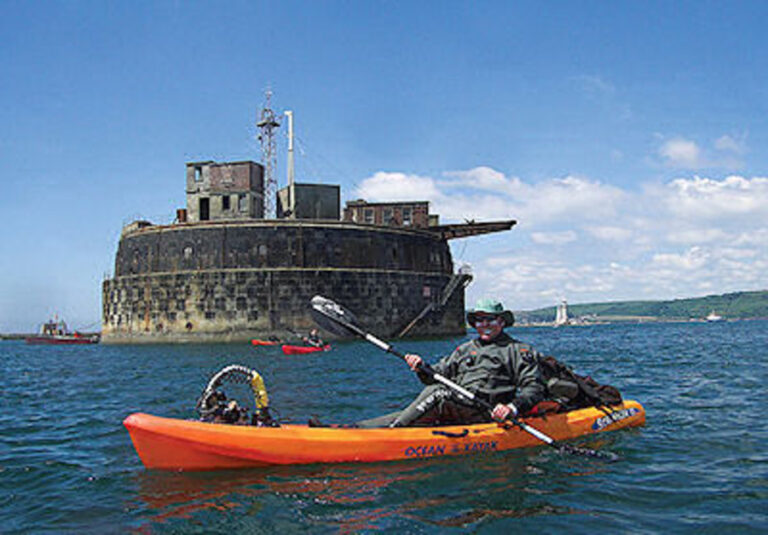Kayaks are ideal for exploring those places between shore and boat-diving distance that divers neglect – extended-range shore diving, if you will. John Liddiard paddles out from Fort Bovisand.

DRIVING DOWN THE HILL to Fort Bovisand brings back memories of some of my earliest diving from Plymouth and BSAC Instructor exams, a feeling of nostalgia augmented by a recent reading of Kendall McDonald’s Fort Bovisand guide in preparation for the trip.
Following a history of the fort, the book covers all the usual offshore dive sites and, more importantly from a kayak-diving point of view, goes into plenty of detail on the shallow sites local to the fort.
Though having said that, Kendall’s history was published 10 years ago, so doesn’t include the more recent Bovi scandals (News, October).
On a hot and sunny midweek day, Fort Bovisand is quiet. Apart from us, there are just a few divers from the Joint Services Sub-Aqua Club, which is still based in the old casemates.
JSSAC has been the sole user of the fort for the past few years, since the commercial dive school closed down, though it doesn’t have it to itself since Discovery Divers opened a new dive center at the fort.
ONE OF THE GUYS from Discovery Divers collects our 2 parking fees and confirms that, as it’s not busy, it’s OK to park on the harbour wall, conveniently next to the slipway.
Compared to some alternative locations I had considered, this is incredibly cheap, especially as there is no launch fee for the kayaks.
To minimise overheating in diving suits, we set up the kayaks and carry them to the water’s edge before changing.
Like any dive boat, kayaks need safety equipment, though as we are operating four as a group, we treat them as one boat for this purpose, with a boat’s worth of flares, radios, A-flag and anchors distributed between them.
Single cylinders are strapped into a recess at the back of each kayak, weightbelts in the middle between our knees, and other bits and pieces such as fins, dive lights and cameras strapped to the bow.
The kayaks are fitted with plenty of bungee lines and clips to make sure everything is held securely and can’t be lost in the event of a capsize.
BEFORE DEPARTING, we dunk ourselves in the water to cool off. Paddling while wearing a drysuit is a hot and sweaty prospect, so two of our team have reverted to wetsuits.
Paddling into a light headwind, it’s an easy 35-minute journey halfway across Plymouth Sound to the Breakwater Fort, pausing to give way to some incoming boats, and to take photographs.
Once loaded, the sit-on-top kayaks are comfortably stable and no one falls off on the way, though we do dowse ourselves with water now and then to prevent overheating.
Like many diving adventures, this one had all begun in the pub. Cold Guinness in hand, I had the impression that Keith, the club DO, was concerned that I might disapprove of what he was about to tell me.
‘We’re thinking of getting a couple of dive kayaks,’ he had said, waiting for me to say something like: ‘Why do we want kayaks? Total waste of money, buy some new regulators and save the rest!’
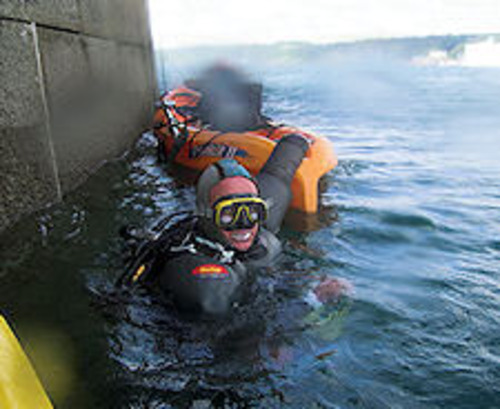
Instead, I surprised him. ‘Great idea. Great opportunity. Can you stretch the budget to get four?’
Keith recovered from the shock soon enough, and I explained that to make a go of kayak-diving you need four kayaks for four divers, two down and two on the surface, taking turns to dive and provide boat cover.
A few years back I had introduced myself to kayak diving in California, taking myself for a dive on a wreck about 300m from the nearest beach (Paddling In Catalina, June 2000), then not been on a kayak since.
The potential for kayak-diving in the club is something on which we can easily agree.
With a high turnover of young, fit and healthy members without a great deal of cash to spare, there is a blockage getting enough cheap boat-diving trips organised for a critical mass of experienced divers to be maintained.
There is no shortage of actual diving in the club, with one or more trips every weekend, but too much of it is shore-diving because there is no cost to it other than transport.
Kayak-diving would be just as cheap, but would also enable divers to be a bit more adventurous and build experience of both seamanship and diving.
KEITH SPENT THE WINTER reviewing the range of dive kayaks available from several manufacturers.
The club procured a quartet of Ocean Kayak Scrambler 11 boats from the Family Adventure Store in Trowbridge, the ’11’ standing for the 11ft (3.35m) length. My trip to the Breakwater Fort is not the kayaks’ first outing.
Club-members have already been gaining experience with the new toys. All they needed to turn shore-diving into a kayak-diving trip was one or two roof racks, depending on the size of car.
To get the kayaks to Bovisand we had towed them strapped to a boat trailer.
The Breakwater Fort is a circular stone and iron edifice constructed in Victorian times to close a gap in the gun coverage of the approaches to Plymouth Sound.
More recently, it was used as a platform for commercial diver training by the dive school at Fort Bovisand.
Nowadays, it is unused and partly derelict, though old cables still hang from the sides, and a gantry on the north side marks where training divers used to be lowered in a lift-cage to the seabed 10m below.
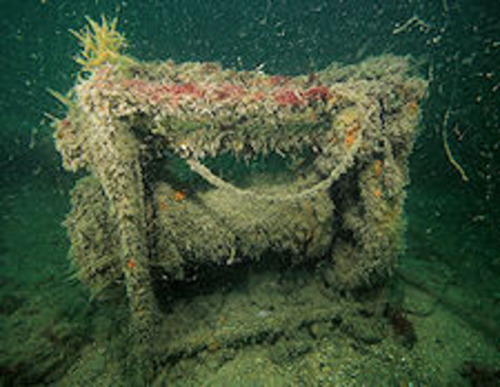
It is the remains of this lift-cage, now abandoned on the seabed, that form the first piece of wreckage on my dive.
Splitting into pairs, we had tied two of the kayaks off to old cables hanging down the side of the fort, my buddy and I pulling on our dive kit at first on the kayak, then finishing while in the water.
The other two divers lent a hand where they could but, more importantly, stayed safely on their kayaks to act as our surface cover.
Something that catches many new visitors to the Breakwater Fort dive-site by surprise is that there is a fair amount of wreckage about the base.
A lot of it was put there for commercial diver training, but the seabed has also been used as a parking place for other bits of wreckage, and a dumping ground for anything from washing machines to mopeds.
It is actually a better collection than at many inland dive sites, nice and close together, with the bonus of plenty of marine life.
From the cage I head down the slope and out to the north-east, soon encountering a line stretched just above the seabed, now well covered in marine slime, but still indicating the route between two of the attractions.
NAVIGATION ASSURED, the first of the diver training props I encounter is one of two concrete pillars, held upright by wide flanged bases.
The concrete is now covered with a turf of bryozoans and hydroids, with patches of encrusting sponge and the occasional clump of dead men’s fingers, but less marine life than on some of the other structures.
The bases have been undercut by the gentle tide that flows past, though a quick look below reveals no crabs or lobsters today.
Between the two concrete pillars, the remains of the 7m wooden pilot-boat Tavy were pinned to the seabed by piling it full of chain.
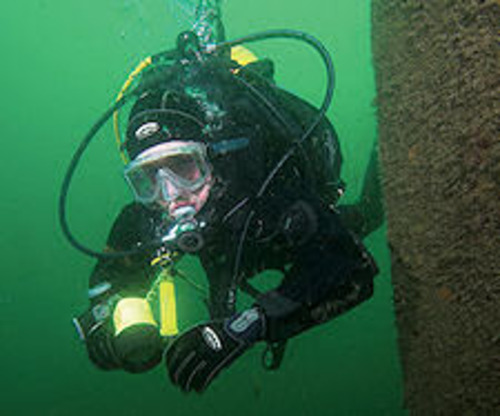
This was a prop added to the site to assist in testing various archaeological survey methods in 1996.
The seams have now split and the stern is broken, but a fair amount of the original boat remains.
Nearby, another archaeological artefact is an iron cannon. This was nothing to do with the fort, and pre-dates it by a few hundred years, having been placed here for safe keeping after it was recovered from the 1691 wreck of the Coronation.
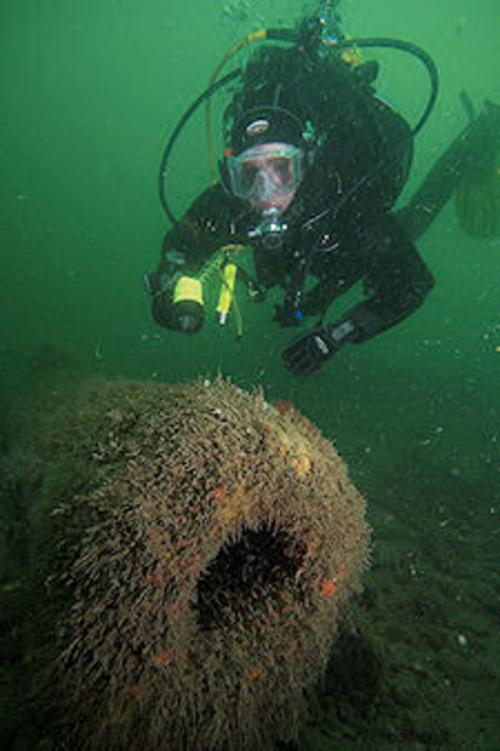
The guns of the Breakwater Fort were much larger, being 12.5in-bore rifled muzzle-loaders weighing 38 tons each.
RETURNING CLOCKWISE and following the guidelines, the next structure, almost straight out from the bottom of the steps, is a triangular frame of steel tube rising a few metres from the seabed.
This was built as a training construction project by the commercial diving school.
Continuing clockwise on the 12m seabed, a decaying structure almost straight out from the gantry is the one with the most diving history.
A heavy base supports a broken steel frame that used to support a cylinder, now fallen among the legs of the frame.
Some 3.7m long and 2.1m in diameter, this used to be the underwater habitat Glaucus, lived in for seven days by divers Colin Irwin and John Heath in September 1965.
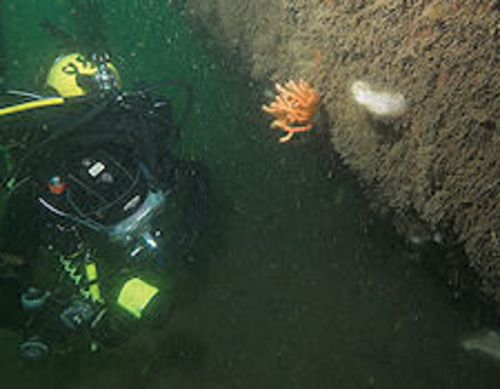
A surface-based crew of supporting divers from Bournemouth BSAC delivered food and other supplies.
Marine life on the frame of Glaucus is getting a bit more spectacular, with some clumps of plumose anemones, but it is the next structure that supports the biggest show of anemones and makes the prettiest photographic backdrop.
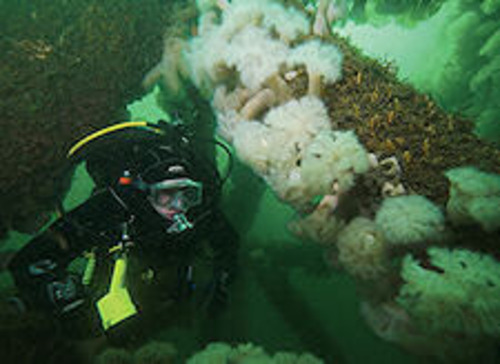
A 7m-long rectangular space-frame structure of thick steel tubes with diagonal bracing was used to train commercial divers on inspecting something that resembled the leg of a North Sea oil rig.
More exposed to the current and sticking up nicely, the plumose anemones love it.
The gaps in the frame are big enough to swim through, so we have fun weaving in and out among the tubes, careful not to squidge against the anemones.
At just 12m down, this would be an ideal prop for teaching advanced buoyancy skills – better than hula-hoops on string.
Further clockwise and to the west, the biggest piece of wreckage is a cylinder on its side, with the ends stepped to half the cylinder. Size is difficult to judge – it’s perhaps 4m in diameter and 8m long.
The central part is closed by bulkheads with small hatches just big enough for a man to climb though. Looking inside, the interior is steps and ladders leading into the gloom.
Very tight for a diver in scuba kit, but it’s another type of oil-rig leg used for training commercial divers.
Diving on the site of the Breakwater Fort actually pre-dates the fort.
In 1867, its construction began with divers working from a bell, laying the foundations at a depth of 10m.
Now mindful of air getting low – I am on open-circuit because I thought a rebreather may be a bit too awkward for the back of a kayak – we head back up the slope towards the base of the fort.
It’s hard to tell just what is rock and what is junk, as there is so much general tat mixed up. Definitely junk is a large winch, perhaps from a boat, or else to do with the lift-cage used to lower divers, which we pass again nearby.
Even back at the wall of the fort, the dive is not over. The fort is faced with stone blocks, and the cracks between them are home to small crabs, squat lobsters and blennies.
I study the granite wall carefully. In the past I have spotted nudibranchs munching away at the tufts of hydroid and bryozoan that just about manage to cling to the granite, but not today.
In the final few meters of ascent, kelp seems to have no problem clinging to the stonework, but is less prolific on the shaded north side where we are diving than on the sunny south.
GETTING BACK ON BOARD a kayak is less difficult than it might seem. I remove most of my kit in the water, pushing it back onto the kayak and clipping it firmly in place with bungee and clips.
Finally, I pull myself across the middle so that I am balanced straight across the kayak face-down, roll onto my back, then turn to sit along the seat with legs dangling either side.
As my guide in California said a few years ago, ‘belly-button, butt and turn’. It still works.
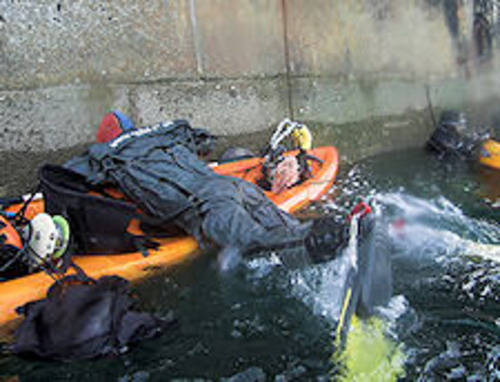
Now it is my turn to sit idly on the surface while the other pair of divers have their turn under water.
My buddy and I paddle lazily around the circular fort following their bubbles, using minimum effort because we don’t want to encourage decompression illness by exercising immediately after a dive.
The others surface. We give them 20 minutes to relax as we drift in the wind and current in the general direction of Fort Bovisand, twitching paddles occasionally to stay together.
Then, with the wind behind us, it takes another 25 minutes to paddle home. Kayaks are ideal for what would be nice shore-diving sites if only there was a convenient bit of shore from which to dive them. It’s a sort of extended-range shore diving.
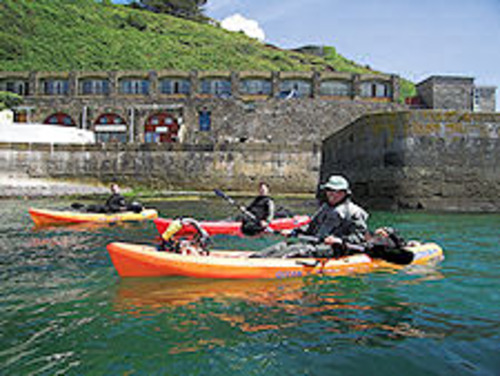
They can’t compete with larger boats for offshore sites, but how many dives get overlooked because they are so close to the launch point that no one bothers with them?
When you’ve gone to the effort of towing and launching a boat, you usually want to go far enough away from the beach to justify it, not stop just round the corner.
If I were going to paddle further, my drysuit would definitely need to be fitted with a pee-valve.
Or perhaps I should have followed the example of our wetsuited pair. You can’t peel off on a kayak and use the transom, like you can on a RIB.
Fact File
- GETTING THERE: Fort Bovisand is on the eastern tip of Plymouth Sound. If you don’t already know how to find it, directions will only confuse you and the road signs from Plymouth are not much help. Be prepared by getting the OS map, a GPS map, or a print-out from Google maps.
- DIVING, AIR & ACCOMMODATION: Discovery Divers, 01752 492 722, Visit Discovery Divers website.
- FURTHER INFORMATION: A marine archaeological survey of the Breakwater Fort can be found at their website. Fort Bovisand, The Diver’s Complete Guide, by Kendall McDonald. Admiralty Chart 1967, Plymouth Sound. Ordnance Survey Map 201, Plymouth and Launceston area.
